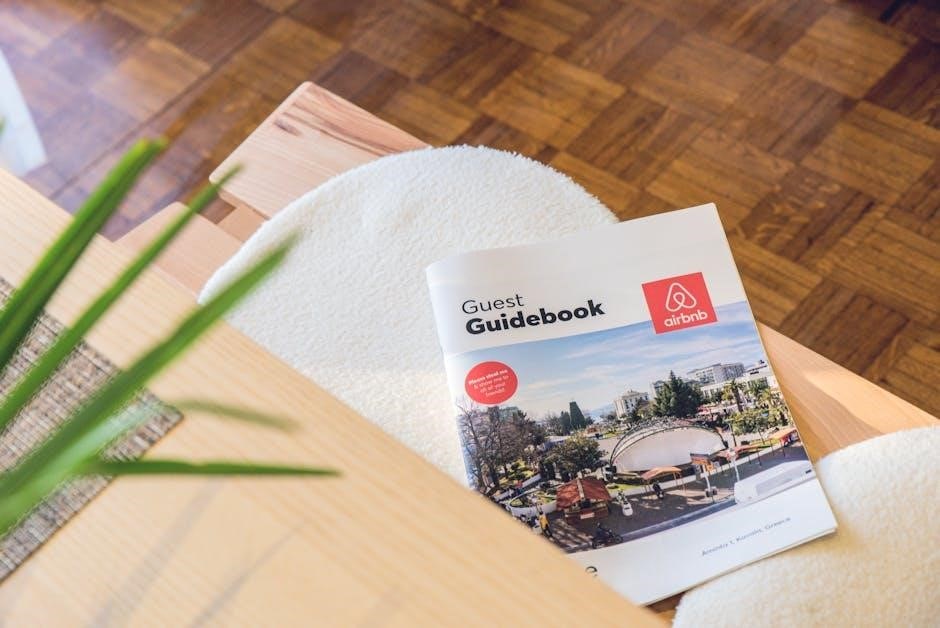
Volos Guide to Monsters is a crucial sourcebook for Dungeons & Dragons, expanding monster lore, character options, and world-building tools for both players and Dungeon Masters.
It offers a deep dive into iconic creatures, their roles, and design philosophies, while introducing new character heritages and subclasses, enriching the game’s versatility and creativity.
With updated mechanics and fresh insights, Volos Guide enhances storytelling and combat dynamics, making it a must-have for enthusiasts seeking to elevate their D&D experiences.
1.1 Background and Overview
Volos Guide to Monsters is a Dungeons & Dragons sourcebook released in 2016, designed to expand the game’s bestiary and deepen the lore surrounding its iconic creatures. It serves as a companion to the Monster Manual, offering detailed insights into the behavior, ecology, and roles of monsters within the D&D multiverse. The guide is named after Volothamp Geddarm, a famed sage whose research drives the book’s content. It introduces new stat blocks, variant rules, and customization options, making it a versatile resource for both players and Dungeon Masters. The book also explores the cultural significance of monsters, their interactions with other races, and their potential as allies or adversaries. Its release marked a significant milestone in D&D’s 5th Edition, enriching the game’s narrative and mechanical depth.
1.2 Key Features and Updates
Volos Guide to Monsters introduces a wide array of new content, including over 150 stat blocks for iconic and lesser-known creatures. It updates classic monsters with fresh mechanics, while adding entirely new entries that expand the D&D bestiary. The guide also includes variant rules for monster customization, allowing Dungeon Masters to tailor encounters to their campaigns. Notable updates involve expanded lore for creatures like mind flayers, yuan-ti, and hags, complete with new abilities and playstyles. Additionally, the book offers racial traits for playable monster heritages, such as goblins, kobolds, and tieflings, enabling players to craft unique characters. These features enhance both storytelling and gameplay, making Volos Guide a standout resource for enriching D&D adventures.
1.3 Design Philosophy and Monster Creation
Volos Guide to Monsters emphasizes a design philosophy that balances creativity with mechanical depth, ensuring each creature feels unique and engaging. The guide provides insights into how monsters are conceptualized, focusing on thematic consistency and tactical variety. It introduces tools for Dungeon Masters to craft encounters that challenge players in innovative ways. The book also explores the art of creating monsters, offering guidelines for tailoring beasts to specific campaign settings. By blending lore and mechanics, Volos Guide encourages storytelling through monster design, making each creature a narrative element. This approach inspires players and DMs alike, fostering a deeper connection to the game’s world and its inhabitants.

Monster Categories and Types
Volos Guide to Monsters categorizes creatures by their roles, origins, and characteristics, offering insights into iconic beasts, fiends, and otherworldly beings. Each type provides unique challenges and lore.
2.1 Iconic Creatures and Their Roles
Volos Guide to Monsters delves into iconic creatures like daemons, demons, and devils, each serving distinct roles in the game’s lore and mechanics. Daemons embody decay and death, while demons thrive on chaos and destruction. Devils, meanwhile, represent lawful evil, often acting as master strategist villains. These fiends are not just enemies but also tools for shaping compelling narratives and encounters.
Hags and their coven mechanics add another layer of complexity, emphasizing collaboration and cunning. These creatures are designed to challenge players in unique ways, blending combat, roleplay, and problem-solving. Their roles go beyond mere adversaries, enriching the game’s depth and replayability.
2.2 Daemons, Demons, and Devils
Daemons, demons, and devils are central to Volos Guide to Monsters, each embodying distinct evil archetypes. Daemons, born from decay and death, serve as harbingers of demise, often manipulating events to spread entropy. Demons, chaotic and destructive, thrive on carnage and mayhem, with iconic types like the Glabrezu exemplifying their brutal nature. Devils, lawful and cunning, operate as master strategists, with figures like Asmodeus ruling hellish realms. These fiends are not just enemies but tools for crafting intricate narratives, with their lore and mechanics designed to challenge players morally and tactically. Their roles in the game highlight the depth of D&D’s cosmic conflicts and the complexity of evil in its multiverse.

2.3 Hags and Their Coven Mechanics
Hags in Volos Guide to Monsters are malevolent beings with unique abilities and coven mechanics. They come in three types: Green, Sea, and Night hags, each with distinct traits. Green hags thrive in swamps, using illusions and disease, while Sea hags rule ocean depths with curses andcontrol over water. Night hags, the most powerful, weave dark magic and manipulate dreams. A key feature is their ability to form covens, where three hags unite to cast enhanced spells, creating formidable encounters. These mechanics add depth to storytelling, allowing DMs to craft intricate plots and challenges. Hags also interact with other fiends, offering rich potential for alliances or rivalries, making them versatile antagonists in D&D campaigns. Their coven mechanics highlight teamwork and strategy, enriching both combat and narrative experiences.
2.4 Pantheons and Divine Beings
Pantheons and divine beings in Volos Guide to Monsters explore the intricate relationships between gods, mortals, and the Multiverse. The guide details various pantheons, each with unique domains, rituals, and followers. Divine beings, such as gods, demigods, and exarchs, are portrayed with distinct personalities and motivations, offering rich narrative potential. Their influence shapes world-building, as their followers and worship practices create dynamic campaign settings. The guide also introduces mechanics for divine magic, blessings, and curses, allowing players and DMs to integrate these elements seamlessly. By exploring these divine hierarchies, the guide enhances the lore and depth of D&D, enabling immersive storytelling and character development rooted in cosmic and theological themes.

Character Options and Customization
Character options in Volos Guide to Monsters expand racial heritages and subclasses, allowing players to craft unique characters inspired by monstrous traits. This enhances storytelling and gameplay versatility.
3.1 Race Options and Monster HERITAGES
Volos Guide to Monsters introduces expansive race options, allowing players to embrace monstrous heritages like Goliath, Kenku, and Firbolg. These races offer unique cultural backgrounds and abilities.
Each heritage provides distinct traits, such as the Goliath’s Mountain Born resilience or the Kenku’s skilled mimicry. These options enrich character creation with lore-infused customization.
Players can craft characters deeply tied to D&D worlds, blending racial identities with class builds for diverse and dynamic play experiences that stand out in any campaign setting.
3.2 Subclass and Feat Interactions
Volos Guide to Monsters seamlessly integrates with existing subclasses and feats, offering fresh synergies for players. Each monstrous heritage and race pairs uniquely with popular subclasses.
For example, the Goliath’s Mountain Born trait complements the Fighter’s Champion archetype, enhancing resilience. Similarly, the Kenku’s Natural Mimicry ability works in harmony with the Rogue’s Arcane Trickster.
Feats like Grappler or War Caster also find new applications with Volos’ races, creating versatile character builds. These interactions expand customization, allowing players to craft unique strategies.
This synergy ensures that every race and subclass combination feels intentional and balanced, enriching the gameplay experience for both players and DMs alike;
3.3 Backgrounds and Monster Themes
Volos Guide to Monsters introduces unique backgrounds and themes that tie characters to monstrous lore, enhancing role-playing depth. These backgrounds, such as the “Haunted One” or “Mercenary,” provide flavorful starting points.
Each background is designed to integrate seamlessly with monstrous heritages, allowing players to craft characters deeply connected to their race’s identity. Themes like “Outlander” or “Sage” further customize these connections.
These options encourage creative storytelling, enabling players to weave their character’s history into the game’s narrative. By linking backgrounds to monster themes, Volos Guide fosters a cohesive and immersive experience.
This integration enhances customization, making each character feel distinct while maintaining balance with class features and campaign settings.

World-Building and Lore
Volos Guide to Monsters enriches D&D lore by detailing monster ecologies, cultural significance, and their roles in shaping worlds, offering tools for crafting immersive and cohesive campaign settings.
4.1 Monster Ecology and Environments
Monster ecology in Volos Guide to Monsters delves into how creatures interact with their environments, shaping ecosystems and influencing campaign worlds. Each monster is contextualized within its habitat, from dragons dominating mountain skies to hags thriving in swampy isolation. The guide explores how these beings adapt, hunt, and coexist, offering insights into their roles as predators, prey, or symbiotic partners. Environmental interactions are detailed, such as how terrain affects lairs and behaviors, providing depth for world-building. This section helps Dungeon Masters craft immersive settings where monsters feel integral to the world, enhancing storytelling and encounter design. By understanding monster ecologies, players and DMs alike gain a richer appreciation of the interconnectedness of D&D worlds.
4.2 Role of Monsters in Campaign Settings
Monsters in Volos Guide to Monsters are not just adversaries but integral elements of campaign settings, shaping stories and worlds. They serve as antagonists, plot devices, or even unexpected allies, adding depth to narratives. The guide highlights how monsters reflect the themes and tone of a campaign, whether as symbols of corruption, guardians of ancient secrets, or harbingers of chaos. By integrating monsters into the fabric of the setting, DMs can create cohesive and immersive worlds where encounters feel meaningful and connected. This approach encourages storytelling beyond combat, allowing monsters to influence politics, cultures, and environments, making them vital to the campaign’s identity and player engagement.
4.3 NPCs, Allies, and Enemies
Volos Guide to Monsters explores how monsters can serve as nuanced NPCs, allies, or enemies, adding depth to campaigns. These creatures often possess unique personalities, motivations, and backstories, making them more than just combat encounters. Monsters like hags, daemons, and dragons can form complex relationships with players, offering quests, alliances, or rivalries. The guide provides mechanics for such interactions, including coven rules and lair actions, allowing DMs to craft memorable encounters. By blurring the line between foes and friends, the guide enriches storytelling and player engagement, encouraging creative problem-solving and moral dilemmas. This approach transforms monsters into dynamic elements of the narrative, shaping the world and its inhabitants in meaningful ways.

Advanced Combat and Tactics
Volos Guide to Monsters offers advanced combat strategies, including encounter building, terrain tactics, and lair mechanics. It enhances gameplay with legendary actions and CR systems, helping DMs create dynamic challenges.
5.1 Building Encounters and CR System
Volos Guide to Monsters provides detailed guidance on building balanced encounters using the Challenge Rating (CR) system. It helps DMs assess monster strength, ensuring encounters suit party levels and sizes.
The guide emphasizes tailoring combat experiences by mixing creatures, environments, and objectives. It offers insights into adjusting CR for customization, ensuring encounters remain dynamic and challenging without overwhelming players.
Optional rules and strategies allow DMs to adapt encounters to their campaigns, making combat more engaging. This section is essential for creating memorable and balanced fights, enhancing the overall D&D experience.
5.2 Terrain and Environmental Interactions
Volos Guide to Monsters delves into how terrain and environments shape encounters, offering insights into monster behaviors and ecological roles. DMs learn to leverage landscapes like forests, mountains, and dungeons to create immersive and dynamic combat scenarios.

Environmental interactions, such as weather effects or hazards, add depth to encounters, challenging players creatively. Monsters’ adaptability to their habitats is explored, emphasizing strategic positioning and resource use.

By integrating terrain mechanics, DMs can craft unique, setting-specific battles, making each encounter feel authentic and linked to the world’s lore, enhancing both storytelling and gameplay immersion.
5.3 Legendary Actions and Lair Mechanics
Volos Guide to Monsters introduces advanced combat mechanics through legendary actions and lair mechanics, enhancing encounters with powerful creatures. Legendary actions allow monsters to perform unique, high-impact abilities outside the typical turn structure, creating dynamic and unpredictable battles. Lair mechanics further immerse players in the monsters’ domains, granting creatures special powers tied to their environments. These features emphasize strategic thinking and adaptability, as players must contend with both the monster’s abilities and the environmental hazards of its lair. By integrating these mechanics, DMs can craft epic showdowns that highlight the monster’s lore and strengths, elevating combat encounters to unforgettable experiences that blend strategy and storytelling seamlessly.

Homebrew and Custom Content
Volos Guide to Monsters empowers DMs to craft unique creatures and adventures, offering tools and inspiration for creating balanced, immersive custom content tailored to their campaigns.
6.1 Creating Your Own Monsters
Creating custom monsters in Volos Guide to Monsters involves balancing stats, crafting unique abilities, and tailoring lore to fit your campaign’s theme. The guide provides frameworks for designing monsters that align with D&D’s CR system, ensuring encounters remain challenging yet fair. By understanding monster roles and playtesting, DMs can refine their creations to enhance storytelling and gameplay. The process encourages creativity, allowing for the integration of personal narratives and world-building elements. Tips on ability design and stat allocation help maintain balance, making homebrew monsters integral to any adventure. This section empowers DMs to craft memorable foes that leave a lasting impact on players.
6.2 Balancing Homebrew Content
Balancing homebrew content in Volos Guide to Monsters ensures that custom creations enhance gameplay without disrupting the game’s equilibrium. The guide emphasizes playtesting to gauge effectiveness and fun. By analyzing the Challenge Rating system and comparing abilities to official monsters, creators can adjust stats for fairness. Designers should focus on clear mechanics and avoid overly complex rules. Feedback from players and DMs is crucial for refinement. Balancing homebrew content fosters a dynamic and enjoyable experience, allowing custom monsters to seamlessly integrate into any campaign. This process ensures that creativity and fairness go hand in hand, making every encounter engaging and memorable for all players involved.
6.3 Integrating Custom Creatures
Integrating custom creatures into your campaign requires careful planning to ensure they fit seamlessly into the game’s world and mechanics. Start by defining the creature’s role—whether it’s a fearsome boss, a cunning ally, or a mysterious encounter. Use Volos Guide to Monsters as a reference to balance its stats, ensuring its Challenge Rating (CR) aligns with the party’s strength. Consider its lore and how it interacts with the campaign’s story and setting. Playtest the creature in low-stakes encounters to gauge its effectiveness and adjust its abilities accordingly. Provide a vivid description to bring the creature to life, enhancing immersion for your players. Finally, remain open to feedback, tweaking the creature based on player experiences to ensure it enhances the game without causing imbalance. By following these steps, you can create engaging, unique encounters that enrich your campaign.

Multiverse and Cross-Setting Play
Volos Guide to Monsters explores the multiverse, detailing how creatures traverse planes and interact across diverse settings, offering insights to enhance cross-setting adventures and campaign integration.
7.1 Monsters Across Different Settings
Volos Guide to Monsters showcases how iconic creatures thrive across various Dungeons & Dragons settings, adapting their lore and mechanics to fit diverse worlds like Forgotten Realms, Greyhawk, and Eberron.
Each setting influences monster behaviors, habitats, and roles, ensuring they remain consistent yet unique. For instance, the beholder’s lair in one world might mirror its theme but differ in specifics, while the mind flayer’s origins vary subtly.
This adaptability highlights the guide’s design philosophy, blending core monster identities with setting-specific twists. It empowers Dungeon Masters to seamlessly integrate these creatures into any campaign, enriching storytelling and world-building efforts across the multiverse.
7.2 Interaction with Planes and Realms
Volos Guide to Monsters delves into how creatures interact with various planes and realms, shaping their behaviors and roles within the multiverse. Monsters like demons and angels are deeply tied to their native planes, such as the Abyss or Acheron, influencing their abilities and motivations. The guide explores how these beings traverse planes, interact with mortal realms, and shape the lore of their environments. This section provides rich context for integrating monsters into plane-hopping adventures, offering insights into their ecological and narrative roles. By connecting monsters to specific planes, the guide enhances storytelling potential, allowing Dungeon Masters to craft encounters that feel deeply rooted in the game’s cosmic structure. This adds depth to the multiverse and enriches world-building efforts.
7.3 Mordenkainens Tome of Foes Connections
Volos Guide to Monsters and Mordenkainens Tome of Foes share thematic and mechanical connections, particularly in their exploration of planar entities and cosmic threats. Both books delve into the lore of iconic races like gith, tieflings, and mind flayers, offering complementary insights into their origins and roles. Monsters such as the daemon and demon entries in Volos Guide align with the planar focus of Mordenkainens Tome, providing a cohesive narrative for Dungeon Masters. The guides collectively enhance the multiverse’s depth, allowing for seamless integration of content. By bridging these sourcebooks, players and DMs can craft stories that explore the intricate relationships between planes, races, and divine forces, enriching campaigns with layered lore and gameplay opportunities.
Volos Guide to Monsters concludes as an essential D&D sourcebook, enhancing storytelling, gameplay, and customization. Its comprehensive approach to monster lore and mechanics solidifies its place as a must-have for enthusiasts.
8.1 Importance of Volos Guide in D&D
Volos Guide to Monsters stands as a cornerstone of Dungeons & Dragons, revolutionizing how players and DMs interact with creatures and lore. It enriches campaigns with detailed monster ecologies, innovative character options, and expansive world-building tools. By blending storytelling depth with mechanical versatility, it empowers DMs to craft immersive encounters while offering players unique heritages and subclasses. The guide’s emphasis on design philosophy and customization sets a new standard for monster creation, making it indispensable for enhancing both narrative and combat experiences. Its influence extends beyond gameplay, inspiring creativity and fostering a deeper connection to the D&D multiverse, solidifying its importance as a modern classic in the franchise.
8.2 Future of Monster Design
Volos Guide to Monsters has redefined monster design in D&D, setting a new standard for depth and creativity. Its focus on balancing lore with mechanics inspires future designs to be more narrative-driven and mechanically diverse. The guide’s emphasis on dynamic creatures and immersive storytelling suggests a trend toward monsters that are not just enemies but integral parts of the world’s fabric. Homebrew content and community contributions will likely play a larger role, fostering a collaborative evolution of monster design. Advanced rules like legendary actions and lair mechanics will continue to enhance encounters, making monsters feel more alive and interconnected with their environments. This approach ensures that future monster design will be both innovative and deeply rooted in the game’s rich lore.